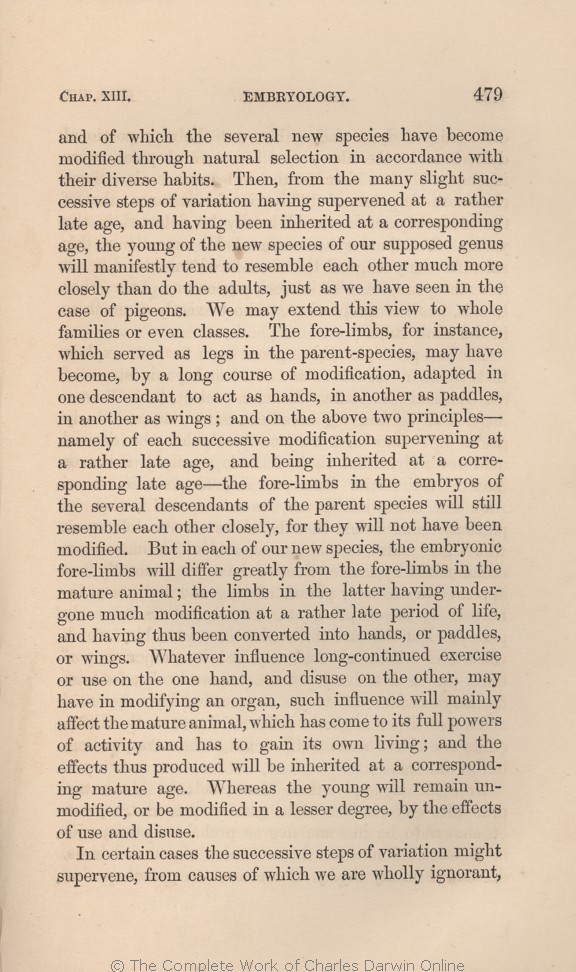modified through natural selection
in accordance with their diverse | in accordance with their diverse 1859 1860 1861 1866 |
| for different 1869 1872 |
| steps of 1859 1860 1861 1866 | steps of 1869 1872 |
| variation 1859 1860 1861 1866 | | variations 1869 1872 |
| at a rather late 1859 1860 1861 1866 |
| in the several species at a not early 1869 1872 |
| of the new species of our supposed genus will manifestly tend to 1859 1860 1861 1866 |
| will be left but little modified and will 1869 |
| will have been but little modified, and they will still 1872 |
| adults, 1859 1860 1861 1866 | | adults,— 1869 1872 |
| in 1859 1860 1861 1866 | | with 1869 1872 |
| case 1859 1860 1861 1866 | | breeds 1869 1872 |
| pigeons. 1859 1860 1861 1866 | | the pigeon. 1869 1872 |
| whole families or even 1859 1860 1861 1866 |
| widely distinct structures and to whole 1869 1872 |
| served 1859 1860 1861 1866 | | once served 1869 1872 |
| in the parent-species, may have become, by 1860 1861 1866 |
| in the parent-species, may become, by 1859 |
| to a remote progenitor, may have become, through 1869 1872 |
| and 1859 1860 1861 1866 | | but 1869 1872 |
| principles— namely of each successive modification supervening at a rather late age, and being inherited at a corresponding late age— 1859 1861 1866 |
| principles— namely of each successive modification supervening at a rather late age, and being inherited at a corre- sponding late age— 1860 |
| principles 1869 1872 |
| in 1859 1860 1861 1866 |
| will not have been much modified in 1869 1872 |
| the 1859 1860 1861 1866 | | these 1869 1872 |
| descendants of the parent species will still resemble each other closely, for they will not have been modified. 1861 |
| descendants of the parent-species will still resemble each other closely, for they will not have been modified. 1859 1860 1866 |
| forms; although in each the embryonic fore-limb will differ greatly from that in the adult. 1869 |
| forms; although in each form the fore-limb will differ greatly in the adult state. 1872 |
| of our 1860 1861 1866 | | individual 1859 |
| latter 1859 1860 1861 | | later 1866 |
| influence 1859 1860 1861 1866 1872 | | influence, 1869 |
| long-continued exercise or use on the one hand, and disuse on the other, 1859 1860 1861 |
| long-continued exercise or disuse 1866 |
| moreover, long-continued use or disuse 1869 |
| long-continued use or disuse 1872 |
| in modifying an organ, such influence will mainly affect the mature animal, which has come to its 1859 1860 1861 |
| had in modifying an organ, such influence will mainly affect the mature animal, which has come to its 1866 |
| had in modifying the limbs or other parts of animals, this will chiefly or solely have affected them when mature and when they had to use their 1869 |
| had in modifying the limbs or other parts of any species, this will chiefly or solely have affected it when nearly mature, when it was compelled to use its 1872 |
| of activity and has 1859 1860 1861 1866 |
| OMIT 1869 1872 |
| to 1859 1860 1861 1869 1872 | | had to 1866 |
| its 1859 1860 1861 1866 1872 | | their 1869 |
| effects 1859 1860 1861 1866 1872 | | effect 1869 |
| be inherited 1859 1860 1861 1866 |
| be transmitted to the offspring 1869 |
| have been transmitted to the offspring 1872 |
| a 1859 1860 1861 1869 1872 | | the 1866 |
| mature 1859 1860 1861 1866 1869 | | nearly mature 1872 |
| Whereas 1859 1860 1861 1866 | | Thus 1869 1872 |
| remain unmodified, or 1859 1860 1861 1866 |
| not 1869 |
| not be modified, or 1872 |
| be modified 1859 1860 1861 1866 1869 |
| will be modified only 1872 |
| in a lesser degree, by the effects of use and disuse. 1859 1860 1861 1866 |
| or will be modified in a less degree. 1869 |
| in a slight degree, through the effects of the increased use or disuse of parts. 1872 |
|









